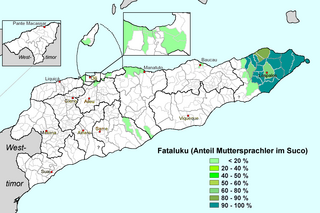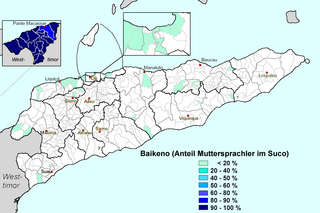In addition to its classical and literary form, Malay had various regional dialects established after the rise of the Srivijaya empire in Sumatra, Indonesia. Also, Malay spread through interethnic contact and trade across the south East Asia Archipelago as far as the Philippines. That contact resulted in a lingua franca that was called Bazaar Malay or low Malay and in Malay Melayu Pasar. It is generally believed that Bazaar Malay was a pidgin, influenced by contact among Malay, Hokkien, Portuguese, and Dutch traders.

The languages of East Timor include both Austronesian and Papuan languages. The lingua franca and national language of East Timor is Tetum, an Austronesian language influenced by Portuguese, with which it has equal status as an official language. The language of the Oecusse exclave is Uab Meto (Dawan). Fataluku is a Papuan language widely used in the eastern part of the country. Both Portuguese and Tetum have official recognition under the Constitution of East Timor, as do other indigenous languages, including: Bekais, Bunak, Galoli, Habun, Idalaka, Kawaimina, Kemak, Lovaia, Makalero, Makasae, Mambai, Tokodede and Wetarese.
Bantik is an endangered Austronesian language, perhaps a Philippine language, of North Sulawesi, Indonesia. It is the traditional language of the Bantik people, who are now switching to Manado Malay as their language for everyday communication, though Bantik is still used as a marker of ethnic identity.

Fataluku is a Papuan language spoken by approximately 37,000 people of Fataluku ethnicity in the eastern areas of East Timor, especially around Lospalos. It is a member of the Timor-Alor-Pantar language family, which includes languages spoken both in East Timor and nearby regions of Indonesia. Fataluku's closest relative is Oirata, spoken on Kisar island, in the Moluccas of Indonesia. Fataluku is given the status of a national language under the constitution. Speakers of Fataluku normally have a command of Tetum and/or Indonesian.
Mongondow, or Bolaang Mongondow, is one of the Philippine languages spoken in Bolaang Mongondow Regency and neighbouring regencies of North Sulawesi (Celebes) and Gorontalo Provinces, Indonesia. With more than 200,000 speakers, it is the major language of the regency. Historically, it served as the official language of the Bolaang Mongondow Kingdom.
The Mentawai language is an Austronesian language, spoken by the Mentawai people of the Mentawai Islands, West Sumatra, Indonesia.
The Minahasan languages are a subgroup of the Austronesian languages spoken by the Minahasa people in northern Sulawesi, Indonesia. They belong to the Philippine subgroup.
The Timoric languages are a group of Austronesian languages spoken on the islands of Timor, neighboring Wetar, and Southwest Maluku to the east.
Alorese is an Austronesian language spoken on Alor and the neighboring islands of the Alor archipelago in eastern Indonesia. It is not to be confused with non-Austronesian (Papuan) languages of the Alor–Pantar family which are also spoken in this region. It is also distinct from Alor Malay, a Malay variety which is currently supplanting Alorese as the language of wider communication in the region. Alorese is the native language of several immigrant communities located along the coast of the Alor archipelago, especially at Alor Kecil on Alor and at Baranusa and Marica on Pantar. It has also been used extensively as a trade language in the region.
Lawangan is an Austronesian language of the East Barito group. It is spoken by about 100,000 Lawangan people living in the central Kalimantan, Indonesia. Lawangan has a high degree of dialectal diversity.
Kei is an Austronesian language spoken in a small region of the Moluccas, a province of Indonesia.

Mor is a nearly extinct Trans–New Guinea language of Indonesia. It is spoken along the Budidi River and the Bomberai River on the Bomberai Peninsula.
The Bima language, or Bimanese, is an Austronesian language spoken on the eastern half of Sumbawa Island, Indonesia, which it shares with speakers of the Sumbawa language. Bima territory includes the Sanggar Peninsula, where the extinct Papuan language Tambora was once spoken. Bima is an exonym; the autochthonous name for the territory is Mbojo and the language is referred to as Nggahi Mbojo. There are over half a million Bima speakers. Neither the Bima nor the Sumbawa people have alphabets of their own for they use the alphabets of the Bugis and the Malay language indifferently.
The Tutong language, also known as Basa Tutong, is a language spoken by approximately 17,000 people in Brunei. It is the main language of the Tutong people, the majority ethnic group in the Tutong District of Brunei.
Talaud is an Austronesian language spoken on the Talaud Islands north of Sulawesi, Indonesia.
Tondano is an Austronesian language spoken in the Tondano area of northeast Sulawesi, Indonesia. It is most similar to Tombulu and to Tonsea.
Taliabo (Taliabu) is a Malayo-Polynesian language spoken on the island of the same name in the Moluccas of Indonesia.
Tonsawang, also known as Tombatu, is an Austronesian language of the northern tip of Sulawesi, Indonesia. It belongs to the Minahasan branch of the Philippine languages.
The Topoiyo language is an Austronesian language of West Sulawesi, Indonesia spoken by people in Tabolang Village, Topoyo subdistrict, Central Mamuju Regency, West Sulawesi. Usually, Topoiyo speakers also speak Mamuju and Indonesian. Topoiyo is also spoken in other villages in Topoyo subdistrict, such as Salulebo, Topoyo, and Salupangkang villages.
Amarasi is a Central Malayo-Polynesian language of West Timor, and is spoken by the Amarasi. The Amarasi language has about 80,000 native speakers, with four main dialects called Ro'is, Kotos, Tais Nonof, and Ketun, though many differences exist between individual villages. It uses Subject-Object-Verb grammar structure. Speakers are interspersed with those of Helong.




